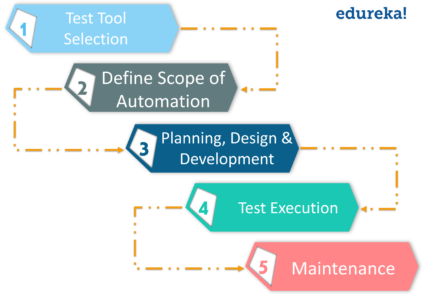Smart Phone Remote Controller ● Widespread Compatibility: Your smartphone can function effectively with the standard connector that is frequently used to replace iOS cellphones.● Plug and Play: Your smartphone may become an…
Automation Testing Tutorial: All You Need To Know About Automation Testing

The prime objective of any software project is to get a high-quality output while reducing the cost and the time required for completing the project.
This is achieved by testing software regularly. Software Testing is an integral part of any IT project.
The software is tested to detect bugs and find issues that may negatively affect the user experience. Testing is mainly classified as Manual Testing and Automation Testing. Through this Automation Testing tutorial, we will learn all about test automation.
You can go through this Automation Testing Tutorial lecture where our Automation Test Engineer Course expert is discussing each & every nitty gritties of the technology.
What is Automation Testing?
Automation Testing is the process of using the assistance of tools, scripts, and software to perform test cases by repeating pre-defined actions. Test Automation focuses on replacing manual human activity with systems or devices that enhance efficiency.
Testing is crucial to the success of any software product. If your software doesn’t work properly, chances are that most people won’t even buy or use your software product, if they did at least not for long. But testing to find defects or bugs manually is time-consuming, expensive, often repetitive, and subject to human error. This is where automation comes into the picture. Automation is essential for software development teams to keep pace with the rising demands for higher-quality software at lightning speed.
When you begin testing, one of the primary decisions that you’ll have to make is if you’re going to test manually or use automated testing. So, you should be aware of the distinct differences between manual testing and automated testing.
Difference between Manual Testing and Automation Testing
| Features | Manual Testing | Automation Testing |
|---|---|---|
| Accuracy & Reliability | Low, as manual tests are more prone to human error | High, as tools and scripts are used |
| Time required | High | Relatively Low |
| Investment Cost | Low, Return of Investment(ROI) is low | High, Return of Investment(ROI) is high |
| Usage | Suitable for Exploratory, Usability and Ad hoc Testing | Suitable for Regression Testing, Performance Testing, Load Testing |
| Human Element | Allows for human observation to find out any glitches | No human observation involved |
| Customer Experience | Helps in improving the customer experience | No guarantee of positive customer experience |
Neither of these options are technically better or worse than the other. But the size, budget and time allowance of a project will certainly be determining factors that affect which method will work best in your testing procedure. Manual testing allows a human mind to draw insights from a test that might otherwise be missed by an automated testing program. While automated testing is well-suited for large projects that require testing the same areas over and over again. But can we automate every test case?
Go for Manual Testing Certification and become a certified expert.

Selenium Certification Training Course
Which test cases to automate?
Well, it’s impossible to automate all testing, so it is important to determine which test cases should be automated. Some test cases where you can apply automation are:
- Repetitive tasks are prime candidates for automation. Not only are these tasks boring to you, but they’re often the ones where you make mistakes.
- Rather than manually exporting your data, crunching the numbers, and making complex graphs by yourself, invest in a tool or automation strategy that will do this for you.
- You can apply automation for the tests that require multiple data sets. Instead of manually typing in information into forms, automate the process.
- Another good case where you can apply automation is load testing.
- You can apply automation for test cases that run on several different hardware or software platforms and configurations.
By now you know when to perform Automation Testing. In the next part of this Automation Testing Tutorial, we will discuss a step-by-step procedure that will help you draw up an automation plan. If you want to go beyond this blog tutorial & dive deep into Automation, you should definitely visit Automation Testing Certification by Edureka!
How do you perform Automation Testing?
Success in test automation requires careful planning and design work. The following steps are followed in an automation process:

Test tool selection
Any process starts with the definition, so before applying to test automation you should define the goal of automation. Once you are sure of what kind of tests are you performing, you need to select the tool. There are several kinds of testing tools available, however, choosing the right tool that suits your test requirements, is very important for automation. Consider these key pointers while selecting an automation tool:
- Is it easy to develop and maintain the scripts for the tool or not?
- Does it work on platforms like web, mobile, desktop etc?
- Does the tool have a test reporting functionality?
- How many testing types can this tool support?
- How many languages does the tool support?
Define the scope of automation
Next, you define the scope of automation, as in you need to decide which test cases to automate. Some pointers that you can follow are:
- Scenarios which have a large amount of data
- Test cases which have common functionalities across applications
- Technical feasibility
- The extent to which business components are reused
- The complexity of test cases
Planning, Design, and Development
After determining your goal and which types of tests to automate, you should decide what actions your automated tests will perform. Planning, design, and development include:
- Developing Test Cases: Develop test cases of your choice. Don’t just create test cases that test various aspects of the application’s behavior all at one time. Large, complex automated tests are always very difficult to edit and debug. It is best to divide your tests into several simple, logical and smaller tests.
- Developing Test Suites: Develop test suits to hold your test cases. Test suites make sure that the automated test cases run one after another without any manual intervention. This can easily be done by creating a test suite that has multiple test cases, a library and command line tool that runs the test suite.
Test Execution
Automation Scripts are executed during this phase. Execution can be performed using the automation tool directly or through the test management tool which will invoke the automation tool. To get the most out of your automated testing, testing should be started as early as possible and executed as often as needed. The earlier testers get involved in the life cycle of the project the better, and the more you test, the more bugs you find.
Software Testing Training
SELENIUM CERTIFICATION TRAINING COURSE
Selenium Certification Training Course
MANUAL TESTING CERTIFICATION TRAINING COURSE ONLINE
Manual Testing Certification Training Course Online
MOBILE APP TESTING USING APPIUM
Mobile App Testing Using Appium
CONTINUOUS TESTING IN DEVOPS
Continuous Testing in DevOps
AUTOMATION TESTING USING TESTCOMPLETE 11.0
Automation Testing using TestComplete 11.0
PERFORMANCE TESTING USING JMETER
Performance Testing Using JMeter
SOFTWARE TESTING FUNDAMENTALS COURSE
Software Testing Fundamentals Course
Maintenance
Once test cases are executed, the next step is to create reports so that the actions performed during testing are recorded. As new functionalities get added to the software that you are testing with successive cycles, automation scripts need to be added, reviewed and maintained for each release cycle. Maintenance becomes necessary to improve the effectiveness of automation.
So, you can follow these steps when performing Automation Testing to get efficient results. Next comes the automation tools. There are several innovative Automation Testing tools but before we discuss that, we need to understand the different kinds of approaches to automation.
Different approaches to Automation Testing
The three main approaches that you can consider to perform Automation Testing are as follows:

- Code-Driven: Here the focus is mainly on test case execution to find out if the various sections of code are performing as per expectations or not. Code-driven testing approach is a popular method used in agile software development.
- Graphical user interface (GUI) testing: Applications that have GUIs can be tested using this approach. Testers can record user actions and analyze them any number of times. Test cases can be written in a number of programming languages like C#, Java, Perl, Python etc.
- Test Automation Framework: Framework is a set of guidelines used to produce beneficial results of the automated testing activity. It brings together function libraries, test data sources, object details, and other reusable modules. Different types of frameworks include:
- Linear Scripting Framework: Recording and replaying test scripts in a sequential or linear fashion.
- Data-driven Framework: Focused on separating the test scripts logic and the test data from each other.
- Keyword-driven Framework: Based on the keywords specified in the excel sheet test scripting is done and tests are executed.
- Modular Testing Framework: Testers divide the application into multiple modules and create test scripts individually.
- Hybrid Testing Framework: A combination of frameworks to leverage the strengths of each.
Basically, these are the ways you can implement automation while software testing. Now let’s move ahead with our Automation Testing Tutorial and find out some of the best tools used for Automation Testing.
Automation Testing Tools
Selecting an automated testing tool is essential for test automation. There are a lot of automated testing tools on the market, and it is important to choose the automated testing tool that best suits your overall requirements. Consider these key points when selecting an automated testing tool:
- Understand your project requirements thoroughly and identify the testing scenarios that you want to automate.
- Search for the list of tools that suit your project’s requirements.
- Identify your budget for the automation tool.
- Now compare each tool for key criteria like: is it easy to develop and maintain the scripts for the tool or not, does it work on platforms like web, mobile, desktop etc. Does the tool have a test reporting functionality? How many testing types can this tool support? How many languages does the tool support?
- Once you have compared the tools, select the tool which is within your budget. Make sure it gives you more advantages based on the key criteria listed above.
Now that you know how to select an appropriate tool, let’s move ahead with this Automation Testing Tutorial and list out some of the best tools used for Automation Testing.

- Selenium – Selenium is a popular testing framework to perform web application testing across various browsers and platforms like Windows, Mac, and Linux.
- Watir – Watir, pronounced as water, is an open source testing tool made up of Ruby libraries to automate web application testing.
- Ranorex – Ranorex is flexible, all in one, GUI testing tool using which you can execute automated tests flawlessly throughout all environments and devices.
- Appium – Appium is an Open source mobile test automation software is free and supported by a highly active community of developers and experts.
This brings us to the end of this Automation Testing Tutorial. I hope you found it informative and it has helped in adding value to your knowledge.

Selenium Certification Training Course
Weekday / Weekend BatchesSee Batch Details
Edureka is a trusted online learning company with a network of more than 250,000 satisfied learners spread across the globe. This training will help you gain deep knowledge in Robotic Process Automation and hands-on experience in Automation Anywhere. Take your automation skills to new heights by earning your Automation Anywhere Certification to validate your expertise in RPA and boost your career prospects.
Got a question for us? Please mention it in the comments section of this ‘Automation Testing Tutorial’ article and we will get back to you.
Upcoming Batches For Selenium Certification Training Course
| Course Name | Date | |
|---|---|---|
| Selenium Certification Training Course | Class Starts on 10th July,2023MON-FRI (Weekday Batch) | View Details |
| Selenium Certification Training Course | Class Starts on 14th August,2023MON-FRI (Weekday Batch) | View Details |







